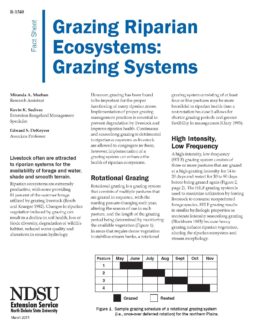Miranda Meehan, a graduate student from North Dakota State University, created five extension fact sheets after monitoring and reporting on the riparian ecosystem associated with the Middle Sheyenne River, a perennial stream in eastern North Dakota.
A riparian zone or riparian area is the interface between land and a river or stream. Riparian ecosystems are transitional ecosystems occurring between terrestrial ecosystems, where hydrology has little influence, and aquatic ecosystems, where hydrology has a significant impact on ecosystem function and formation (Gregory et al. 1991; Naiman et al. 1993; Svejcar 1997).
“The majority of the riparian corridor of the Middle Sheyenne is forest, native rangeland, or undisturbed grassland. Currently, most of this area is utilized for forage by domestic livestock in animal production systems,” said author Meehan. “Increased information concerning the plant communities and proper grazing management of the riparian corridors of the Middle Sheyenne will help ranchers utilize these areas in a way that is both sustainable and profitable.”
They created a 5-sheet factsheet series, which can be downloaded below.
- Grazing Riparian Ecosystems: Grazing Systems
- Grazing Riparian Ecosystems: Grazing Intensity
- Grazing Riparian Ecosystems: Season of Use
- Grazing Riparian Ecosystems: Water Developments
- Riparian Ecosystems of North Dakota
Want more information? See the related SARE grant:
- Maintenance of Natural Sustainable Riparian Communities Located Within the Middle Sheyenne Watershed (GNC09-113)
This material is based upon work that is supported by the National Institute of Food and Agriculture, U.S. Department of Agriculture through the Sustainable Agriculture Research and Education (SARE) program. Any opinions, findings, conclusions, or recommendations expressed in this publication are those of the author(s) and should not be construed to represent any official USDA or U.S. Government determination or policy.
